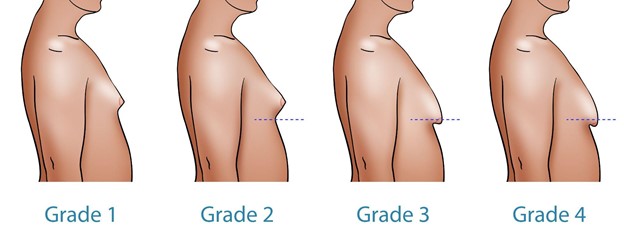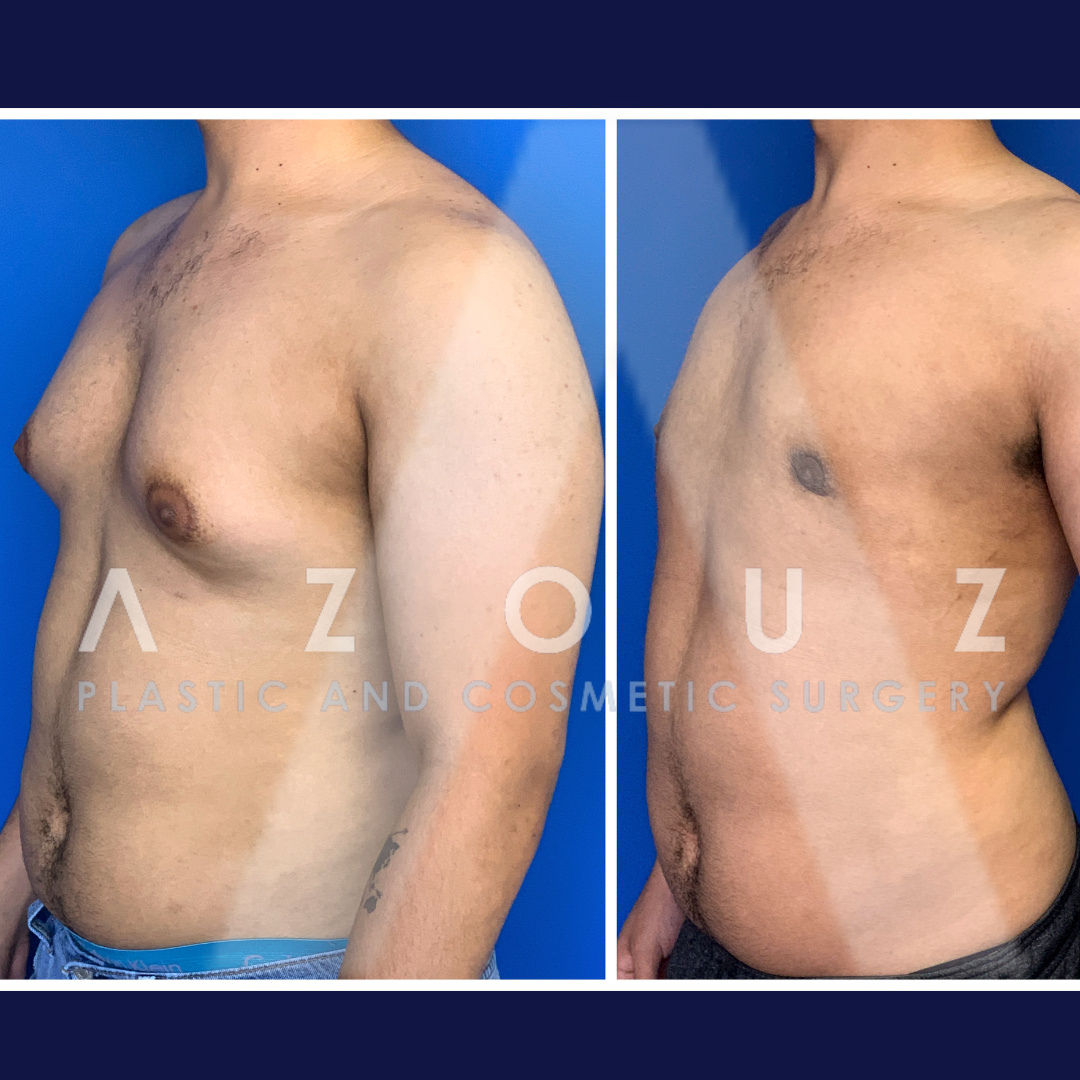How do I know my grade of Gynecomastia?
Gynecomastia is a condition that can occur in men of all ages. Fat is trapped and intermixed with firm breast tissue with any amount of Gynecomastia. With diet and exercise, the firm breast tissue (Gynecomastia) makes it very hard to lose. This unusually dense breast tissue can distort the chest and lead to unwanted aesthetic changes. Some patients can have considerable breast tissue, and their skin can sag. Gynecomastia is graded according to skin elasticity and the amount of firm breast tissue.
A highly skilled plastic surgeon can diagnose, grade, and treat gynecomastia in all age groups. Dallas Plastic Surgeons Dr. David Azouz and Dr. Solomon Azouz are known for their techniques to correct gynecomastia in primary and revision gynecomastia surgery in Dallas, Texas, for men of all ages and body types.
Determining the grade of Gynecomastia
Board-certified Dr. Azouz explains what gynecomastia of varying grades looks like below.

Grade one: “mild” Gynecomastia without sagging
In mild cases, the chest looks normal and does not have excess skin. Some grading scales quantify the amount of Gynecomastia in grams, but this isn’t easy to do before the time of surgery. Therefore, most plastic surgeons define Grade 1 Gynecomastia as a slight or “mild” enlargement of the breast glands without skin excess.
Grade two: “moderate” Gynecomastia with or without some sagging
When a patient has moderate gynecomastia but still does not have skin excess, they are usually deemed to be a grade 2. This means they have more breast tissue than a mild grade one but do not have breast sag. Some plastic surgeons break up grade twos into 2a and 2b, which means that 2bs has minor skin excess. Regardless of the grading system, most plastic surgeons label a grade 2 as those with a “moderate” amount of gynecomastia.
Grade three: “severe” gynecomastia with mild sagging
When a patient has a severe amount of gynecomastia but still does not have extreme skin excess, they are usually deemed a grade 3. This usually means they have more than 500 grams of fat and breast tissue within their chest.
Grade four: “severe” gynecomastia with “severe” sagging
When a patient has a severe amount of gynecomastia and sagging, usually deemed a grade 4, this usually means their breasts sag as a woman’s would when she had large, sagging breasts. A patient with grade four gynecomastia would usually have severely enlarged areolas pointing toward the floor.




How Can I Tell If I Have Gynecomastia?
Early signs may include firm or fatty tissue in the breast or a feminine appearance to the breast or areola. As the condition progresses, some patients may notice sagging to their breasts with contours that resemble a woman’s breast. Men who are dissatisfied with the look or feel of their chest should seek evaluation and treatment by a board-certified plastic surgeon who performs a high volume of gynecomastia surgery, such as Dr. Azouz.
How Common is Gynecomastia?
Overall, research shows that gynecomastia is very common and may affect as many as seventy percent of men at some point in their lives. There are different levels of severity, ranging from almost unnoticeable to severe, with sagging of the breast and female appearance. Regardless of age, gynecomastia surgery can be beneficial to patients of all body types and severity.
Can I Prevent Gynecomastia?
In many patients, gynecomastia is unavoidable and genetically inherited. Avoiding the triggers of gynecomastia is essential, even after surgery, to prevent a recurrence.
What Causes Gynecomastia?
The cause of gynecomastia varies from person to person. There are several accepted theories on what causes gynecomastia.
The most common cause is usually genetic. When patients think of their family history, they often recognize a family member with a similar body type who also had gynecomastia.
There are many different drugs and medications that can cause or contribute to gynecomastia. These include:
- Anabolic Steroids
- Antiandrogens (Finasteride)
- Antimicrobials (Isoniazid, Ketoconazole, and Flagyl)
- Antireflex drugs (Cimetidine, Omeprazole)
- Cardiac Drugs (Calcium channel blockers, Captopril, Digoxin, Methyldopa, Reserpine, and Spironolactone)
- Psychiatric Drugs (Diazepam, Thioridazine, and Tricyclic antidepressants)
- Illicit Drugs (Alcohol, Amphetamines, Anabolic steroids, Opioids, Heroin, Methadone, Marijuana)
- Drugs for HIV/AIDS (Antiretrovirals)
Medical conditions can also cause gynecomastia. These include medical problems:
- Androgen resistance syndrome
- Klinefelter’s syndrome
- Hyperthyroidism
- Hyperprolactinemia
- Kidney Disease
- Obesity
- Cancer
Some cases, however, do not seem to have a genetic link or identifiable risk factor.
Some patients will still have gynecomastia, even those with no risk factors.
What Does Gynecomastia Feel Like?
Depending on the severity, gynecomastia usually presents as firm, spongey, or lumpy tissue underneath the areola. Gynecomastia can cause a lack of confidence and poor aesthetics in men of various severities.
How Can I Get Rid of My Gynecomastia?
Gynecomastia surgery is the most effective treatment for getting rid of it. This procedure involves liposuction and the removal of the thick breast and fatty tissue.
Gynecomastia can be very frustrating, as many patients report having it for many years, beginning in puberty. Most patients report being unable to improve their gynecomastia despite effective workouts and dieting.
Gynecomastia Specialists in Dallas,TX
If you are worried about the appearance of your breasts, the first step is to schedule a consultation with Dr. David Azouz and Dr. Solomon Azouz, leading plastic surgeons in Dallas, Texas. Expertly trained, both board-certified plastic surgeons are highly skilled in correcting gynecomastia.
After a thorough evaluation and discussion of your goals, Dr. Azouz will develop a plan of care to restore and rejuvenate your chest to a more sculpted appearance free from Gynecomastia. If you consider gynecomastia or revision gynecomastia surgery, Dr. Azouz can assist you in his Dallas office through an in-person or virtual consultation. Schedule your consultation by calling us at (972) 702-8888.
Posted on behalf of
